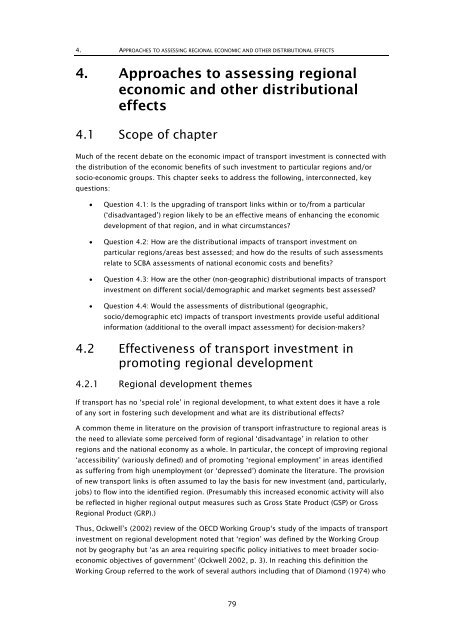Research 350 - NZ Transport Agency
Research 350 - NZ Transport Agency
Research 350 - NZ Transport Agency
Create successful ePaper yourself
Turn your PDF publications into a flip-book with our unique Google optimized e-Paper software.
4. APPROACHES TO ASSESSING REGIONAL ECONOMIC AND OTHER DISTRIBUTIONAL EFFECTS<br />
4. Approaches to assessing regional<br />
economic and other distributional<br />
effects<br />
4.1 Scope of chapter<br />
Much of the recent debate on the economic impact of transport investment is connected with<br />
the distribution of the economic benefits of such investment to particular regions and/or<br />
socio-economic groups. This chapter seeks to address the following, interconnected, key<br />
questions:<br />
• Question 4.1: Is the upgrading of transport links within or to/from a particular<br />
(‘disadvantaged’) region likely to be an effective means of enhancing the economic<br />
development of that region, and in what circumstances?<br />
• Question 4.2: How are the distributional impacts of transport investment on<br />
particular regions/areas best assessed; and how do the results of such assessments<br />
relate to SCBA assessments of national economic costs and benefits?<br />
• Question 4.3: How are the other (non-geographic) distributional impacts of transport<br />
investment on different social/demographic and market segments best assessed?<br />
• Question 4.4: Would the assessments of distributional (geographic,<br />
socio/demographic etc) impacts of transport investments provide useful additional<br />
information (additional to the overall impact assessment) for decision-makers?<br />
4.2 Effectiveness of transport investment in<br />
promoting regional development<br />
4.2.1 Regional development themes<br />
If transport has no ‘special role’ in regional development, to what extent does it have a role<br />
of any sort in fostering such development and what are its distributional effects?<br />
A common theme in literature on the provision of transport infrastructure to regional areas is<br />
the need to alleviate some perceived form of regional ‘disadvantage’ in relation to other<br />
regions and the national economy as a whole. In particular, the concept of improving regional<br />
‘accessibility’ (variously defined) and of promoting ‘regional employment’ in areas identified<br />
as suffering from high unemployment (or ‘depressed’) dominate the literature. The provision<br />
of new transport links is often assumed to lay the basis for new investment (and, particularly,<br />
jobs) to flow into the identified region. (Presumably this increased economic activity will also<br />
be reflected in higher regional output measures such as Gross State Product (GSP) or Gross<br />
Regional Product (GRP).)<br />
Thus, Ockwell’s (2002) review of the OECD Working Group‘s study of the impacts of transport<br />
investment on regional development noted that ‘region’ was defined by the Working Group<br />
not by geography but ‘as an area requiring specific policy initiatives to meet broader socioeconomic<br />
objectives of government’ (Ockwell 2002, p. 3). In reaching this definition the<br />
Working Group referred to the work of several authors including that of Diamond (1974) who<br />
79
















